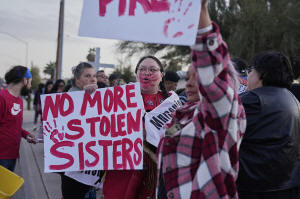San Carlos Apache teenager's death reverberates throughout Indian
Country
[March 07, 2025]
By SEJAL GOVINDARAO
PHOENIX (AP) — From heartbreak and devastation to outrage, Emily Pike's
tragic death is stirring heavy emotions and spotlighting a crisis that
has long plagued Native American communities, where a disproportionate
number of people have been killed or have gone missing.
In the case of the San Carlos Apache teenager, she disappeared from her
group home in a Phoenix suburb in late January.
Authorities posted her picture on social media, saying she was missing
and had possibly run away. It was nearly a month later that sheriff's
deputies in a neighboring county reported finding and identifying Pike's
remains more than 80 miles (129 kilometers) from where she was last
seen.
Since then, news of her brutal death has reverberated through Indian
Country and beyond. A crowd gathered Thursday at an intersection in
Mesa, near her group home, to honor Pike's life and to press for changes
that might help curb the violence.
Dozens of people of all ages from various tribal nations viewed the
vigil's program on a large inflatable projector. Clad in red, they
embraced, shielded candle flames on the windy night and held posters
that read “No more stolen sisters” and “Justice for Emily Pike.”
A trio no more
Four of Pike's cousins, all close in age to her, recounted a girl they
knew as a funny, kind and happy person who loved animals, K-Pop and
Roblox. Jadyn Palmer, 15, said she and Tyraya Steele, another 15
year-old cousin, grew up with Pike on the San Carlos Apache reservation.
The three were a trio and were always by each other's side and laughing,
Palmer said.

She said Pike would call her every so often and the last time they spoke
was just weeks before she disappeared. In their last conversation, Pike
shared she was going to return to the reservation within a month. Palmer
and Steele became excited about the shopping trips they wanted to plan.
“We're not going to have a trio anymore,” Palmer told The Associated
Press, her voice choking up with Steele by her side.
Tony Dunkin and his 12-year-old daughter performed a jingle dance, which
he said has an origin of healing. Dunkin’s father spoke in Apache before
the dance, and sang a lullaby.
Mary Kim Titla, a member of the San Carlos Apache Tribe, wore pink —
Pike’s favorite color — to the vigil and said the teen had dreamed of
becoming a veterinarian.
“These tears that are shed are a part of a healing process,” Titla said.
Titla has three female relatives who went missing and were killed. She
said the community has come together to honor Pike and to demand
justice. This shared solidarity comes from a desire for healing from
historical and generational trauma, she said.
“It affects so many people,” Titla said, “and I think the reason is
because we all know someone.”
Advocates say the crisis of stems from colonization and forced removal,
which marginalized Indigenous people by erasing their culture and
identity. Limited funding, understaffed police departments and a
jurisdictional checkerboard that hinders authorities from working
together have only exacerbated the issue.
‘Everyone’s daughter'
Pike's case has drawn the attention across social media. Some have
shared photos of themselves, their mouths covered with a red handprint
that has become emblematic of the movement to end the violence. Posts
included the hashtags #NoMoreStolenSisters, #SayHerName and #JusticeforEmily.
In Wisconsin, organizers planned for their own candlelight vigil. Fliers
in Colorado encouraged people to wear red, and Daisy Bluestar, a
Southern Ute tribal member on Colorado's Missing & Murdered Indigenous
Relatives Task Force, posted a video about Pike.

[to top of second column]
|

People attend a vigil for slain Native American teen Emily Pike in
Mesa, Ariz., Thursday, March 6, 2025. (AP Photo/Samantha Chow)

The girl's basketball team at Miami High School in Arizona wore
jerseys with “MMIW” and a red handprint on the back.
“We’re all mourning this terrible loss of a precious young girl.
Emily really has become everyone’s daughter, granddaughter and
niece,” Titla said.
What happened to Emily?
Pike's remains were found northeast of Globe, Arizona, the Gila
County Sheriffs Office said.
Like many others, her case involves multiple agencies. Gila County
is working with Mesa police, the Bureau of Indian Affairs and the
Federal Bureau of Investigation.
Mesa police typically don't investigate runaway reports, but the
agency did list Pike as missing on its Facebook page two days after
the group home reported she was gone.
Arizona's Department of Child Safety requires notification of a
child's missing status to occur within a day of receiving the
information. However, that requirement doesn't extend to tribal
social services, according to Anika Robinson, president of the
nonprofit foster care advocacy group ASA Now. Pike was in the
custody of San Carlos Apache Tribe Social Services, which could not
be reached for comment, at the time she went missing from the group
home in Mesa.
Mesa police reported Pike as missing to the National Crime
Information Center the evening of Jan. 27. Police have said it would
have been up to the group home to contact her case manager who then
would have contacted Pike's family or tribe.
Pike's mother, Steff Dosela, has said in interviews that she didn't
hear about her daughter’s disappearance until a week later.
Robinson questioned why it took so long.
“Imagine what probably had already transpired by that week,” she
said.
Addressing the crisis
Arizona Gov. Katie Hobbs in 2023 created a task force to identify
policies for addressing the high rates of disappearances and
killings among the Native American population. A final report is due
in 2026.

Washington, New Mexico, Michigan, Wisconsin and Wyoming have created
similar task forces.
President Donald Trump during his first term created the nation's
first task force to begin looking at the problem, dubbing it
Operation Lady Liberty. The Biden administration followed with a
special unit within the Bureau of Indian Affairs, U.S. attorneys'
offices in key areas began taking a closer look at unsolved cases,
and top officials held listening sessions across the nation. Last
month, the federal government launched an initiative to help solve
missing and unidentified person cases.
Tiffany Jiron, executive director of the Coalition to Stop Violence
Against Native Women, said more comprehensive law enforcement
training that address jurisdictional challenges, increased funding
for tribal programs that provide shelter, mental health resources
and legal aid to impacted families and survivors and strengthened
alert systems are among the policy solutions for which advocates
should continue to fight.
“As an Indigenous people, we are not invisible,” she said. “We
deserve just as much attention from law enforcement. Our cases are
involving real people, real families, real children.”
All contents © copyright 2025 Associated Press. All rights reserved |